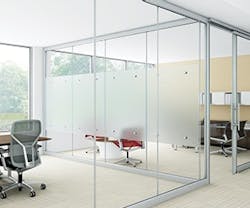The trend toward open floor plans is making a lot of noise in the office world – literally. In response, movable wall manufacturers are boosting acoustical performance while maintaining the flexibility and reconfigurability that made their offerings so attractive in the first place.
Movable walls come in a variety of materials with plenty of options to improve functionality, such as writable surfaces, tackable walls, and technology compatibility. But if the walls don’t perform acoustically, these features hardly seem worth the investment.
Your application will dictate the proper solution. Take the following steps to ensure your occupants don’t sound off with a slew of complaints.
Choose the Right Features
Movable walls can be as simple as glass panels and as complex as finished veneers over gypsum board or sheet metal. They can be personalized with technology, dry erase marker boards, and paint or wallpaper.
The appeal of movable walls has always been their ability to accommodate shifting open plan environments, but these features kick occupant productivity up a notch.
“They’re configurable canvases,” says Shawn Green, vice president of design for manufacturer KI. “Other than definition of space, the big opportunity with walls is maximizing how that space can be used.”
Other offerings can have work surfaces, small shelves, or computer monitor arms hung directly from the wall.
“These items can either determine or support the purpose of a room,” explains Kris Yates, vice president of architectural walls for manufacturer Allsteel. “Privacy panels can be used in executive offices, or interactive surfaces can spur collaboration in meetings or conference rooms.”
Other questions to consider include whether the panels are manual or powered and if accordion or sealed modular partitions are necessary, notes Melissa Rosson, marketing coordinator at manufacturer Modernfold Inc.
This important distinction revolves around simple space management dividers vs. high-performance noise control walls, notes Kenneth DeLasho, general manager of manufacturer IAC Acoustics.
“If you’re just trying to block the line of sight, then dividers and partitions are sufficient,” DeLasho says. “But in sensitive areas like legal, medical, or human resources offices, acoustics aren’t just desired, they’re required.”PageBreak
Ensure Acoustical Performance
Determining the right acoustic solution is in the details. Pay attention to ratings, field reports, and design.
“The sound transmission class (STC) rating is most important, and generally, the higher the better,” explains Ethan Salter, principal consultant with acoustics consulting firm Charles M. Salter Associates, Inc. “But a high STC wall may not be ideal for low frequency noise like machine rooms or night clubs. It pertains mostly to speech.”
STC ratings are found in a laboratory under perfect conditions, so beware of marketing claims, DeLasho notes.
“The more important measure is what happens in the field repeatedly, so ask manufacturers how many installations they can show you that have consistently performed at their claim,” he says. “If an owner deploys a consultant, he or she looks at frequency responses and field performance values. But if you’re limited by cost or project scope and can’t enlist a consultant, those are the things to look at.”
Some clues that a system might perform better than others include panel weight, hanger method, and number of joints, DeLasho adds.
“If you have a system on wheels, it naturally won’t perform as well as one with steel tracks and trolleys,” he says. “If you have a 10-foot wall, two 5-foot panels should perform better than five 2-foot panels because there is less opportunity for sound to get through.”
Optional features like thicker glass, added laminate, and an acoustic interlayer are available to ramp up performance, Yates says.
“Sound is like water. It will find the point of entry or exit and take it,” she says. “It’s the entire system and setting that impact performance, not a single product. There are a lot of moving parts depending on the application.”
Let Application Guide Selection
Because acoustical features come at a premium, honing a solution for your particular situation is important when rationalizing the investment.
“If a large banquet hall can be divided into three rooms, simple space providers allow you to use rooms one and three with room two acting as an acoustical buffer,” DeLasho explains. “Noise control walls would let you rent all three at the same time.”
High-performance acoustical walls are also becoming more desirable in education, healthcare, and offices. In those applications, flexibility is nice, but make sure you’re meeting occupant satisfaction and expectation.
“If you have two conference rooms side by side, there shouldn’t be risk of them interrupting each other,” says Salter. “But if you have everyone in an open office with space providers, your plan should include separate phone booth rooms. There is a tradeoff.”
The changing workforce also presents challenges. “Millennial workers like teams and more creative, less task-intensive work,” Green notes. “But with more collaborative areas, there is an increased need for private, intimate spaces, too. Where do you go for a one-on-one performance review or a personal phone call?”
There is still the need for meetings and focused work, and movable walls allow for four-sided glass rooms in the middle of open plans. “These let you step in for privacy without being separated from the masses,” Yates says.
Set your expectations based on what your application needs. Doing so leads to successful implementation.
“In the long run, movable walls give you better usage of space,” DeLasho says. “But do the homework to make sure that what you get is going to meet your goals.”
Chris Curtland [email protected] is assistant editor of BUILDINGS.
